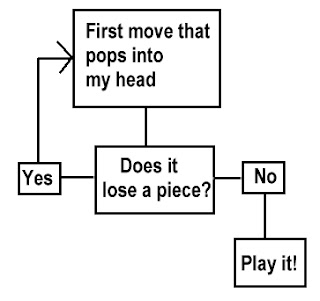This is my latest pdf book. It contains 60 positions from GM games for you to
analyze then decide what you would play.
Large diagrams, one per page. On
the following page are the top five engine lines along with the GM comments and the
actual game continuation with brief notes.
The idea of the format is that when you are sitting at the board you won’t be given any
hints; no one is going to tell you there is a combination that wins a piece or
leads to mate that is available. If there is a sound tactical solution
hiding in the position it will up to you to find it. If there isn’t, you will have to decide on a
reasonable plan of action. Thus, the
positions in this book are the kind you would actually face in an over the
board game and it is up to you to decide whether to play a tactical or
positional line. Just like in a real
game...no hints are given!
There is also a guide, mostly derived from suggestions by
C.J.S. Purdy, detailing how to analyze every position you face.
Also included at the end of the book is a guide containing advice
gleaned from the writings of such well known players as Jonathan Rowson, Steven
Ham and Robin Smith on how to conduct a proper analysis using an engine. 60 positions, 140 pages.
It is available for download for $1.50 at AuthorStand. Note: You must be a member to download from
AuthorStand…it’s
free! At AuthorStand you can
download thousands of pdf books by unknown authors on many different
subjects. Prices range from free and up.
Also available: Lone Pine, a series of tournaments
held from 1971 to 1981 that were sponsored by millionaire Louis D. Statham and
often drew the world's top players. This book has 422 pages of games that
can, if desired, be copied and pasted into a chess engine for analysis, or just
played over for enjoyment - FREE
Here is a sample that was not included in the book:
 |
| White to play |
Petrosian,Tigran -
Gligoric,Svetozar Zurich, 1953
Gligoric had employed a
new idea in the K-Indian where he tried to hasten his K-side break despite the
fact White had castled on the other side.
After a series of errors by both sides Gligoric misses a chance to win
the game and Petrosian regains his winning position.
37.Ne2??
A time pressure error
that gives Black new chances.
1)
37.a3 Rc5 38.Ka1 Ra5 39.Ne2 Rda4 40.Rxc7 Qb8 41.R7c2 Ra8 42.Nc3 4.10
2)
37.Qe1 Rb4 38.Nd1 Raa4 39.Nf2 Rb7 40.Qc3 Qe8 41.b3 Rd4 42.Be2 3.75
3)
37.Qh2 Rb4 38.Bd3 Bh5 39.Rg1 Ra8 40.Qh3 Qc8 41.Qf1 3.71
4)
37.Be2 Rb4 38.Rg1 Rb8 39.h5 Bf7 40.Qh2 Qf6 41.h6 Rg8 42.Rxg8+ 3.63
5)
37.b3! According to Najdorf this is the correct move, but he gave no follow-up.
37...Rb4 38.Bd3 Qe7 39.Rg1 Rb8 40.Qh2 Bf7 41.Qh3 Rc5 42.h5 c6 43.h6 Rg8
44.Rxg8+ Bxg8 45.dxc6 Rxc6 46.Nd5 3.31
37...Rda4??
Missing his one chance
in the whole game! 37...Rxe4!!
Fantastic. What's the point? You'll see. 38.h5 (38.fxe4?? Nxe4 39.Qe1 Qxd5
40.b3 (40.a3 Nd2+ The point! 41.Ka1 Nb3+ 42.Kb1 Nxc1 43.Kxc1 and
it's Black who is winning.) 40...Nd2+ 41.Kb2 (41.Ka1 Nxb3+ 42.Kb2
Rxa2+ 43.Kxa2 Nxc1+ 44.Ka1 Qa8+ 45.Kb1 Qa2+ 46.Kxc1 Qxc2#) 41...Rxa2+
42.Kxa2 Qxb3+ 43.Ka1 Qa3+ 44.Ra2 Nb3#) 38...Bf5! and Black enjoys the
advantage. (38...Bxh5 39.fxe4 Nxe4 40.Qe1 Qxd5 41.b3 does not work
because the check on d2 is not available because the B is no longer on the
b1–h7 diagonal.
38.Nc3 Rd4 39.b3 Qb8
40.h5 Bxh5 41.Qh4 1–0
Black resigned because if 41...Qe8 (or 41...Bg6
42.Qf6+ Kg8 43.Bh3 Nf7 44.Be6 Qf8 45.Ne2 winning) 42.Ne2 Rxe4
43.Rxc7 and wins.



















